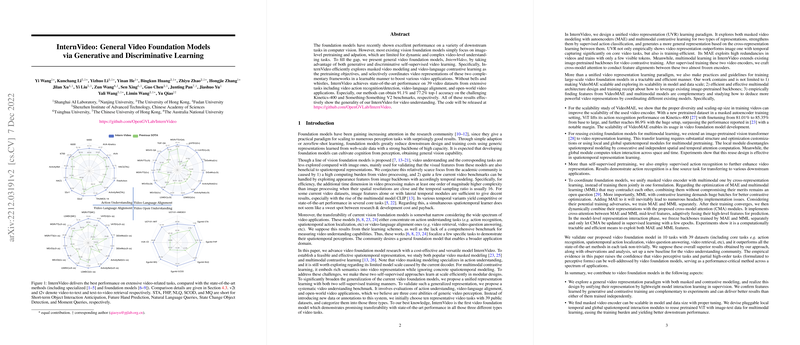Overview of InternVideo: General Video Foundation Models
The paper "InternVideo: General Video Foundation Models via Generative and Discriminative Learning" advances the research landscape in video foundation modeling by introducing InternVideo, a model leveraging both generative and discriminative self-supervised learning techniques. This work addresses the limitations prevalent in current vision foundation models, which predominantly focus on image-level pretraining, thereby failing to capture the dynamic nature of video content.
InternVideo specifically incorporates masked video modeling and video-language contrastive learning as its core pretraining strategies. The model achieves significant improvements across a spectrum of video-related tasks, establishing state-of-the-art results on 39 diverse datasets. These tasks encompass video action recognition and detection, video-language alignment, and video applications in open-world settings, highlighting the comprehensive applicability of the model.
Key Numerical Results and Claims
InternVideo achieves notable top-1 accuracy scores of 91.1% and 77.2% on the Kinetics-400 and Something-Something V2 benchmarks, respectively. Such figures underline its proficiency in video action recognition. The model outperforms existing methods significantly, not only in action recognition but also in video retrieval and video question answering, as evidenced by its superior performance on benchmarks such as MSR-VTT and MSVD.
Technical Approach
InternVideo employs a Unified Video Representation (UVR) paradigm, intelligently integrating both masked autoencoders and multimodal contrastive learning. The approach develops from a scalable VideoMAE framework and involves extending image-pretrained backbones to video contexts through the use of local and global spatiotemporal modules. This process involves the application of supervised action classification to fine-tune video representations. Furthermore, the model implements cross-model attention to harmonize feature alignments between the distinct self-supervised training paradigms.
Implications and Future Developments
InternVideo contributes significantly to the field by setting a high-performance baseline across multiple domains of video understanding. This presents practical implications for industries relying on robust video analysis, such as surveillance, entertainment, and autonomous systems. Theoretically, it pushes the boundaries of knowledge in multimodal learning and broadens the horizon for future research in video foundation models.
Future research might explore the extension of InternVideo's capabilities to long-term video tasks and high-order cognitive challenges, such as anticipatory video processing. The exploration of systematic coordination among multiple foundation models trained across varied modalities presents a promising research avenue. This endeavor could enhance model generality and adaptability in even broader contexts.
In conclusion, InternVideo exemplifies a significant stride in video foundation modeling, emphasizing efficiency and versatility. Its success across an extensive array of datasets marks a pivotal contribution to the video understanding community, with potential long-term impacts on both theoretical investigation and practical applications.
